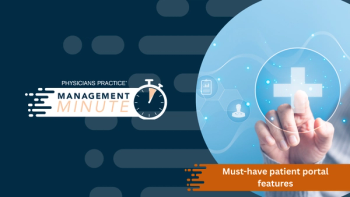
Text messaging can help practices reopen after COVID-19
Engage patients, enhance outcomes, and strengthen productivity.
We'll cut to the chase: This is the time when the value and effectiveness of text messaging really shines. Throughout the nation, practices and other healthcare organizations that greatly reduced or temporarily ceased operations during this pandemic are beginning to reopen or planning how to do so in the coming weeks. For those practices that leverage text messaging, resuming operations will prove more streamlined, safer and ultimately successful. And in a mobile-led world where patient engagement has become an essential strategy, text messaging is a necessity.
Here are 10 of the ways practices can use texting with patients, staff and vendor partners to their advantage during this transitional period.
Trending:
1. Announcing plans to reopen
A great first text to send to all key stakeholders is an announcement from practice leadership that the facility is gearing up to resume operations and more information will be forthcoming, including how safety will be ensured. This mass text will not only help mentally prepare recipients for the time when they will come to the practice for treatment, to work or to provide a service, but it can also serve as welcomed, positive news of the beginning of the return to some semblance of normalcy.
2. Rescheduling canceled appointments
Once a practice determines when it will reopen, this is an apt time to begin sending text messages to those patients who had their appointments cancelled due to stay-at-home orders and social distancing guidelines. Such text messages would provide instructions for how patients can reschedule their appointments (e.g., phone call, form, portal). It can also include information on new safety measures or a hyperlink to a page on the practice's website that details such measures. More than 97 percent of phones can access text messaging and the mobile internet. Including hyperlinks is a useful way to engage patients by supplementing information in the text. Including the practice's phone number here is also an effective way to further engage with patients and encourage them to reach out with questions.
Leveraging text messaging to communicate about a practice's ability to accommodate patients is a highly efficient and cost-effective means of maximizing revenue and getting a practice back on track financially.
Read More:
3. Scheduling new appointments
Following outreach to those patients who had their appointments scheduled, it's time to shift focus to scheduling patients in need of treatment who were identified during the shutdown but could not be scheduled. Practices should use texts to help ensure optimization of available space on the patient schedule, which some practices may expand (e.g., add weekend or evening hours) to accommodate the patient backlog and demand. Text messaging should also be used to drive recall campaigns, such as those for annual physicals and Medicare annual wellness visits.
Consider that not every outbound phone call staff members make is answered, but almost every inbound call to a practice during hours of operation is answered. Texting is a great way to inform patients that they need to call the practice. As noted, the text can put the practice's phone number at their fingertips.
Continue reading on page 2...
4. Availability of telehealth services
For those practices already running or planning to develop telehealth programs, text messaging is the most effective way to communicate with a majority of patients and encourage them to take advantage of these virtual services. Nearly all consumers already own mobile phones. Most mobile phones can access the internet and include a camera, and all can receive and interact with text messages. There is little to no learning curve for patients as most know how to use their phone for texting, and most have experience with videotelephony programs (e.g., FaceTime, Skype, Facebook Messenger). There is no need for someone to have wi-fi, a computer, speaker, or even be at home to access telehealth services through their mobile phone.
After scheduling a telehealth appointment, practices can send a text message that includes the direct hyperlink to initiate the consultation and the time when the patient should click the hyperlink. Once the link in the text is selected, a web browser or default videotelephony app will automatically open and the camera on the phone should activate. This makes telehealth simple for patients and helps further optimize the billable time for telehealth visits.
Trending:
5. Providing safety directions to patients
While efforts to "flatten the curve" are working, the risk of contracting COVID-19 remains high in many areas of the country. Practices should use text messages to explain to patients the safety directions they are expected to follow for their appointment. This may include changes to check-in and discharge procedures, wearing of personal protective equipment (PPE) and new waiting room policies.
If a practice wants to speak with patients to review these directions, a text can inform patients about this need and then include the phone number from which the practice staff member will be calling and the time of day patients should expect the call. This will increase the likelihood that patients answer a call from a number they may have otherwise not recognized.
6. Reminding patients about appointments
Texting patients is a proven way to reduce cancellations and no-shows. Prior to an appointment, practices should send a text that reminds patients about their scheduled appointment. The text can also include directions to the practice, safety policies and the practice's phone number if patients have questions. This is also a good time to tell patients that if they are not feeling well, they should reach out to reschedule their appointment.
Read More:
7. Informing staff and vendors about new policies and procedures
As with patients, practices should use texting to tell staff and vendors who will be coming to the facility about changes to policies and procedures, such as those concerning pre-screening, screening upon admission, vendor check-in and wearing of PPE. Such an effective use of mass texting capability can also serve to remind staff and vendors about the need to avoid traveling to the practice if they are unwell.
8. Increase top-line revenue
As discussed, using texting for appointment-related messages reduces cancellations and no-shows. Not only can you more effectively identify which patients plan to keep their appointment, but staff also can identify patients who need to cancel or reschedule. That gives staff a chance to fill that appointment slot with other patients.
Practices can also send well-worded and polite texts reminding patients of their payment responsibility - either upcoming or overdue - and the manner in which they can pay for treatment. Include a link to an online bill pay website if you offer such a payment mechanism. This approach to securing payment is familiar to most people since many other industries already use texting for payment prompts, including most major credit cards and many banks.
9. Keeping stakeholders current on changes
During these uncertain times, policies and procedures in place one day may need to change for the next. Text messaging is a fast, effective way of keeping stakeholders current on rules and expectations. Mass texting is also valuable in the event that a practice must quickly inform stakeholders of a significant development, such as a visitor testing positive for the novel coronavirus.
10. Boosting staff morale
While most text messages sent by practices will concern safety and business matters, there is another beneficial way to use the technology: providing emotional and inspirational support to staff during this unprecedented and uncertain time. Sending an
Related:
There's No Better Time to Add Text Messaging Capability
Text messaging is a proven method for engaging patients, enhancing outcomes, improving staff productivity and strengthening workflow, among other benefits. As text messaging has become the preferred communication method for a growing number of Americans, practices should evaluate how they can incorporate two-way text messaging as a communication platform or further expand its existing use during this transitional period.
Newsletter
Optimize your practice with the Physicians Practice newsletter, offering management pearls, leadership tips, and business strategies tailored for practice administrators and physicians of any specialty.








